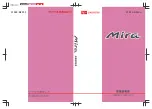
The back seat is the safest place for
a child of any age or size.
In addition, the passenger’s front
airbag poses serious risks to children.
If the seat is too far forward, or the
child’s head is thrown forward
during a collision, or the child is
unrestrained or out of position, an
inflating front airbag can kill or
seriously injure the child.
The side airbag also poses risks. If
any part of a larger child’s body is in
the path of a deploying airbag, the
child could receive possibly serious
injuries.
Whichever style you select, follow
the booster seat maker’s instructions.
The National Highway Traffic Safety
Administration and Transport
Canada recommend that all children
ages 12 and under be properly
restrained in the back seat.
If a child needs a booster seat, we
recommend choosing a high or low-
back style that allows the child to be
directly secured with the lap/
shoulder belt.
A child should continue using a
booster seat until the child exceeds
the booster seat manufacturer’s
requirements.
Even then, the child may still need to
use a booster seat. Note that some
states now require children to use
boosters until they reach a certain
age and/or weight. Be sure to check
current laws in the state or states
where you intend to drive.
When Can a Larger Child Sit in Front
Using a Booster Seat
Protecting Children
Driver and Passenger Saf ety
38
02/01/09 13:58:01 31S3M620 0041
















































